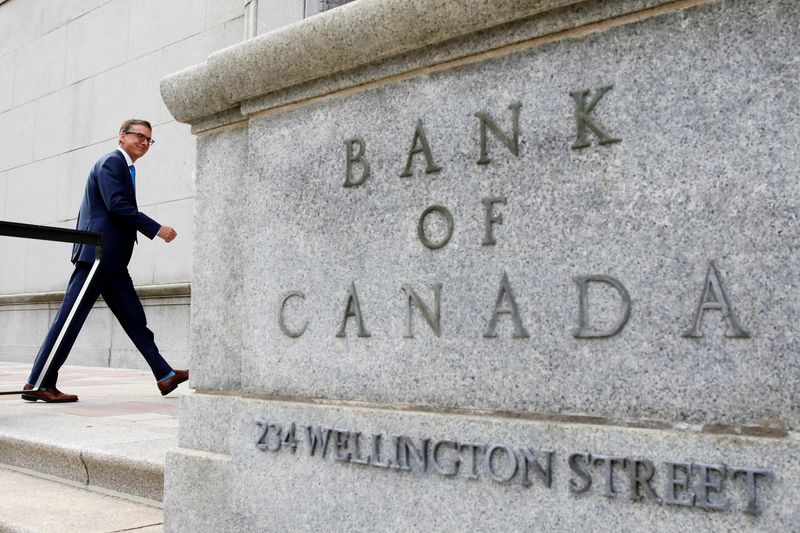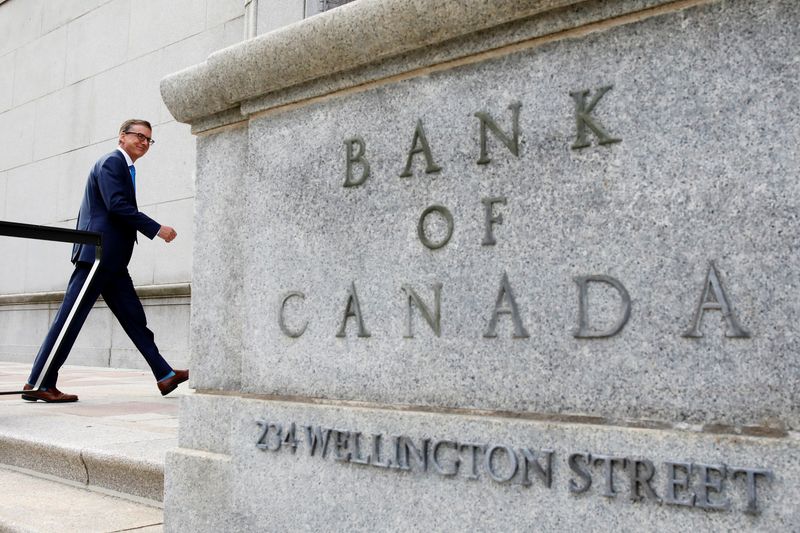Economy
Bank of Canada holds rates, still worried about inflation


© Reuters. FILE PHOTO: Governor of the Bank of Canada Tiff Macklem walks outside the Bank of Canada building in Ottawa, Ontario, Canada June 22, 2020. REUTERS/Blair Gable/File Photo
By Steve Scherer and David Ljunggren
OTTAWA (Reuters) -The Bank of Canada (BoC) on Wednesday held its key overnight rate at 5% and left the door open to another hike, saying it was still concerned about inflation while acknowledging an economic slowdown and a general easing of prices.
The central bank raised rates by a quarter point in both June and July to a 22-year high and has left them on hold in the three policy-setting meetings since. Inflation slowed to 3.1% in October, down from a peak of more than 8% last year, but it has remained above the bank’s 2% target for 31 months.
“Governing Council is still concerned about risks to the outlook for inflation and remains prepared to raise the policy rate further if needed,” the BoC said in an unusually curt, five-paragraph statement.
It said it wanted to see a “further and sustained easing in core inflation.”
The Canadian dollar was trading 0.3% higher at 1.3553 to the greenback, or 73.78 U.S. cents.
But the statement dropped language used in its previous policy statement, which said “progress towards price stability is slow and inflationary risks have increased.”
The BoC instead noted on Wednesday that labor market pressures had eased and growth stalled during the middle part of the year, leaving the economy no longer in excess demand.
“Higher interest rates are clearly restraining spending,” the BoC said. Oil prices are about $10 lower per barrel than it had forecast in October.
“The slowdown in the economy is reducing inflationary pressures in a broadening range of goods and services prices,” the BoC said, noting that October core inflation was at the low end of a range seen in recent months.
“It is a stay-tuned message,” said Derek Holt, vice president of capital markets economics at Scotiabank. “They are pushing back against the market pricing for rate cuts to begin as early as in the first quarter of next year.”
Money markets are betting that there could be a rate cut as early as March, and are pricing in a cut of 25 basis points by April. Governor Tiff Macklem though has said the BoC is not even thinking about easing yet because inflation is still well above target.
“The contrasting signals highlight a Governing Council that is desperately trying to keep markets from pricing in an earlier and more aggressive easing cycle,” said Simon Harvey, head of FX analysis for Monex Europe and Canada.
The BoC forecast in October that inflation would hover around 3.5% until mid-2024, before inching down to its 2% target in late 2025. Macklem last month said interest rates might be at their peak, given excess demand had vanished and weak growth was expected to persist for many months.
“The main message from the Bank is that they believe the rate hikes are truly working,” said Doug Porter, chief economist at BMO Capital Markets. “It’s pretty clear that they’re done raising interest rates and really it’s just a countdown now to when they begin trimming rates.”
Canada’s economy unexpectedly contracted at an annualized rate of 1.1% in the third quarter, avoiding a recession, but most economists forecast that upcoming mortgage renewals at higher rates will take another chunk out of growth next year.
The BoC will start cutting rates in the second quarter of 2024 as inflation and the economy slow, according to a Reuters poll published last week.
Separately on Wednesday, Canada recorded a larger-than-expected trade surplus of C$2.97 billion ($2.19 billion) in October, as exports rose marginally but imports slumped, Statistics Canada said.
The Ivey Purchasing Managers Index (PMI) on Wednesday said Canadian economic activity expanded in November at its fastest pace in seven months.
Economy
Russian central bank says it needs months to make sure CPI falling before rate cuts -RBC


© Reuters. Russian Central Bank Governor Elvira Nabiullina attends a news conference in Moscow, Russia June 14, 2019. REUTERS/Shamil Zhumatov/File Photo
MOSCOW (Reuters) – Russia’s central bank will need two to three months to make sure that inflation is steadily declining before taking any decision on interest rate cuts, the bank’s governor Elvira Nabiullina told RBC media on Sunday.
The central bank raised its key interest rate by 100 basis points to 16% earlier in December, hiking for the fifth consecutive meeting in response to stubborn inflation, and suggested that its tightening cycle was nearly over.
Nabiullina said it was not yet clear when exactly the regulator would start cutting rates, however.
“We really need to make sure that inflation is steadily decreasing, that these are not one-off factors that can affect the rate of price growth in a particular month,” she said.
Nabiullina said the bank was taking into account a wide range of indicators but primarily those that “characterize the stability of inflation”.
“This will take two or three months or more – it depends on how much the wide range of indicators that characterize sustainable inflation declines,” she said.
The bank will next convene to set its benchmark rate on Feb. 16.
The governor also said the bank should have started monetary policy tightening earlier than in July, when it embarked on the rate-hiking cycle.
Economy
China identifies second set of projects in $140 billion spending plan


© Reuters. FILE PHOTO: Workers walk past an under-construction area with completed office towers in the background, in Shenzhen’s Qianhai new district, Guangdong province, China August 25, 2023. REUTERS/David Kirton/File Photo
SHANGHAI (Reuters) – China’s top planning body said on Saturday it had identified a second batch of public investment projects, including flood control and disaster relief programmes, under a bond issuance and investment plan announced in October to boost the economy.
With the latest tranche, China has now earmarked more than 800 billion yuan of its 1 trillion yuan ($140 billion) in additional government bond issuance in the fourth quarter, as it focuses on fiscal steps to shore up the flagging economy.
The National Development and Reform Commission (NDRC) said in a statement on Saturday it had identified 9,600 projects with planned investment of more than 560 billion yuan.
China’s economy, the world’s second largest, is struggling to regain its footing post-COVID-19 as policymakers grapple with tepid consumer demand, weak exports, falling foreign investment and a deepening real estate crisis.
The 1 trillion yuan in additional bond issuance will widen China’s 2023 budget deficit ratio to around 3.8 percent from 3 percent, the state-run Xinhua news agency has said.
“Construction of the projects will improve China’s flood control system, emergency response mechanism and disaster relief capabilities, and better protect people’s lives and property, so it is very significant,” the NDRC said.
The agency said it will coordinate with other government bodies to make sure that funds are allocated speedily for investment and that high standards of quality are maintained in project construction.
($1 = 7.1315 renminbi)
Economy
Russian central bank says it needs months to make sure CPI falling before rate cuts -RBC


© Reuters. Russian Central Bank Governor Elvira Nabiullina attends a news conference in Moscow, Russia June 14, 2019. REUTERS/Shamil Zhumatov/File Photo
MOSCOW (Reuters) – Russia’s central bank will need two to three months to make sure that inflation is steadily declining before taking any decision on interest rate cuts, the bank’s governor Elvira Nabiullina told RBC media on Sunday.
The central bank raised its key interest rate by 100 basis points to 16% earlier in December, hiking for the fifth consecutive meeting in response to stubborn inflation, and suggested that its tightening cycle was nearly over.
Nabiullina said it was not yet clear when exactly the regulator would start cutting rates, however.
“We really need to make sure that inflation is steadily decreasing, that these are not one-off factors that can affect the rate of price growth in a particular month,” she said.
Nabiullina said the bank was taking into account a wide range of indicators but primarily those that “characterize the stability of inflation”.
“This will take two or three months or more – it depends on how much the wide range of indicators that characterize sustainable inflation declines,” she said.
The bank will next convene to set its benchmark rate on Feb. 16.
The governor also said the bank should have started monetary policy tightening earlier than in July, when it embarked on the rate-hiking cycle.

 Forex3 years ago
Forex3 years agoForex Today: the dollar is gaining strength amid gloomy sentiment at the start of the Fed’s week

 Forex3 years ago
Forex3 years agoUnbiased review of Pocket Option broker

 Forex3 years ago
Forex3 years agoDollar to pound sterling exchange rate today: Pound plummeted to its lowest since 1985

 Forex3 years ago
Forex3 years agoHow is the Australian dollar doing today?

 Cryptocurrency3 years ago
Cryptocurrency3 years agoWhat happened in the crypto market – current events today

 World3 years ago
World3 years agoWhy are modern video games an art form?

 Commodities3 years ago
Commodities3 years agoCopper continues to fall in price on expectations of lower demand in China

 Economy3 years ago
Economy3 years agoCrude oil tankers double in price due to EU anti-Russian sanctions



























